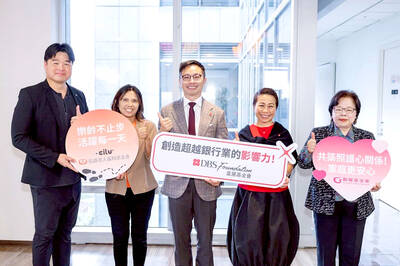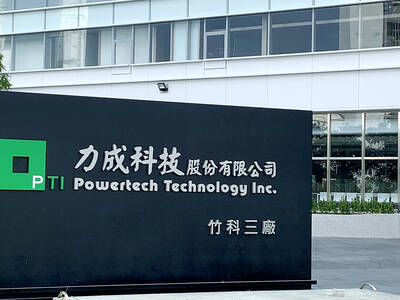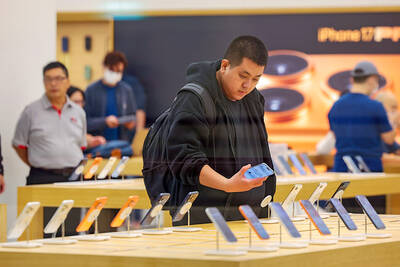Casetek Holdings Ltd (鎧勝), a metal casing supplier for Apple Inc’s MacBooks and iPads, yesterday reported its lowest quarterly earnings performance in its history, due to the delayed launch of the new MacBook Pro.
Casetek’s net profit plunged 77.4 percent annually and 15.8 percent quarterly to NT$366 million (US$11.62 million) in the third quarter, company data showed.
Gross margin over the period dropped to 11.8 percent, a decline of 14.8 percentage points from last year’s 26.6 percent and 4.8 percentage points from the previous quarter’s 16.6 percent.
Operating margin also fell to a record low of 3.9 percent, compared with the same period last year’s 17.4 percent and the previous quarter’s 6.1 percent.
“The weaker-than-expected profitability and gross margin are mainly due to postponed shipments of new notebook computers,” Casetek chief financial officer Jonathan Chang (張昭平) told a teleconference.
Casetek chief executive officer Gary Chuang (莊育志) said revenues should begin to pick up this quarter, and that the recovery would extend through next quarter, as Apple started to ship the new 13-inch and 15-inch MacBook Pros at the end of last month.
Chuang said Casetek secured the orders for the 12-inch MacBook last year and entered the supply chain for the 13-inch and 15-inch MacBook Pros for the first time this year.
“We foresee the revenue contribution from notebooks rising significantly next year,” Chuang said.
Notebooks accounted for 40 percent of the company’s total revenue, while its tablet segment contributed 50 to 60 percent, Casetek said.
When asked if Casetek has made progress winning a smartphone contract with its major client — as the company has for years been trying to enter the supply chain for iPhones — Chuang said: “I believe we will have a good chance next year, given the client’s positive feedback.”
“From iMacs, iPads to MacBooks … the [iPhone] is the only product we have not supplied. We will focus on developing this business next year,” Chuang said.
Chuang said he would not be worried if Apple decided to adopt glass back covers for its new range of iPhones instead of full metal casings next year, because both materials would require casing suppliers’ computer numerical control (CNC) machines and technologies.
Casetek’s board yesterday approved a capital expenditure plan of US$66.12 million for the purchase of 1,000 CNC machines over the end of this year and the beginning of next year, the company said in a filing with the Taiwan Stock Exchange.
Casetek said in a separate filing that its revenue plummeted 37 percent annually and 2.3 percent monthly to NT$2.54 billion last month.
That brought its combined revenues for the first 10 months of the year to NT$25.01 billion, the filing showed.

The DBS Foundation yesterday announced the launch of two flagship programs, “Silver Motion” and “Happier Caregiver, Healthier Seniors,” in partnership with CCILU Ltd, Hondao Senior Citizens’ Welfare Foundation and the Garden of Hope Foundation to help Taiwan face the challenges of a rapidly aging population. The foundation said it would invest S$4.91 million (US$3.8 million) over three years to foster inclusion and resilience in an aging society. “Aging may bring challenges, but it also brings opportunities. With many Asian markets rapidly becoming super-aged, the DBS Foundation is working with a regional ecosystem of like-minded partners across the private, public and people sectors

BREAKTHROUGH TECH: Powertech expects its fan-out PLP system to become mainstream, saying it can offer three-times greater production throughput Chip packaging service provider Powertech Technology Inc (力成科技) plans to more than double its capital expenditures next year to more than NT$40 billion (US$1.31 billion) as demand for its new panel-level packaging (PLP) technology, primarily used in chips for artificial intelligence (AI) applications, has greatly exceeded what it can supply. A significant portion of the budget, about US$1 billion, would be earmarked for fan-out PLP technology, Powertech told investors yesterday. Its heavy investment in fan-out PLP technology over the past 10 years is expected to bear fruit in 2027 after the technology enters volume production, it said, adding that the tech would

YEAR-END BOOST: The holiday shopping season in the US and Europe, combined with rising demand for AI applications, is expected to drive exports to a new high, the NDC said Taiwan’s business climate monitor improved last month, transitioning from steady growth for the first time in five months, as robust global demand for artificial intelligence (AI) products and new iPhone shipments boosted exports and corporate sales, the National Development Council (NDC) said yesterday. The council uses a five-color system to measure the nation’s economic state, with “green” indicating steady growth, “red” suggesting a boom and “blue” reflecting a recession. “Yellow-red” and “yellow-blue” suggest a transition to a stronger or weaker condition. The total score of the monitor’s composite index rose to 35 points from a revised 31 in August, ending a four-month

RUN IT BACK: A succesful first project working with hyperscalers to design chips encouraged MediaTek to start a second project, aiming to hit stride in 2028 MediaTek Inc (聯發科), the world’s biggest smartphone chip supplier, yesterday said it is engaging a second hyperscaler to help design artificial intelligence (AI) accelerators used in data centers following a similar project expected to generate revenue streams soon. The first AI accelerator project is to bring in US$1 billion revenue next year and several billion US dollars more in 2027, MediaTek chief executive officer Rick Tsai (蔡力行) told a virtual investor conference yesterday. The second AI accelerator project is expected to contribute to revenue beginning in 2028, Tsai said. MediaTek yesterday raised its revenue forecast for the global AI accelerator used